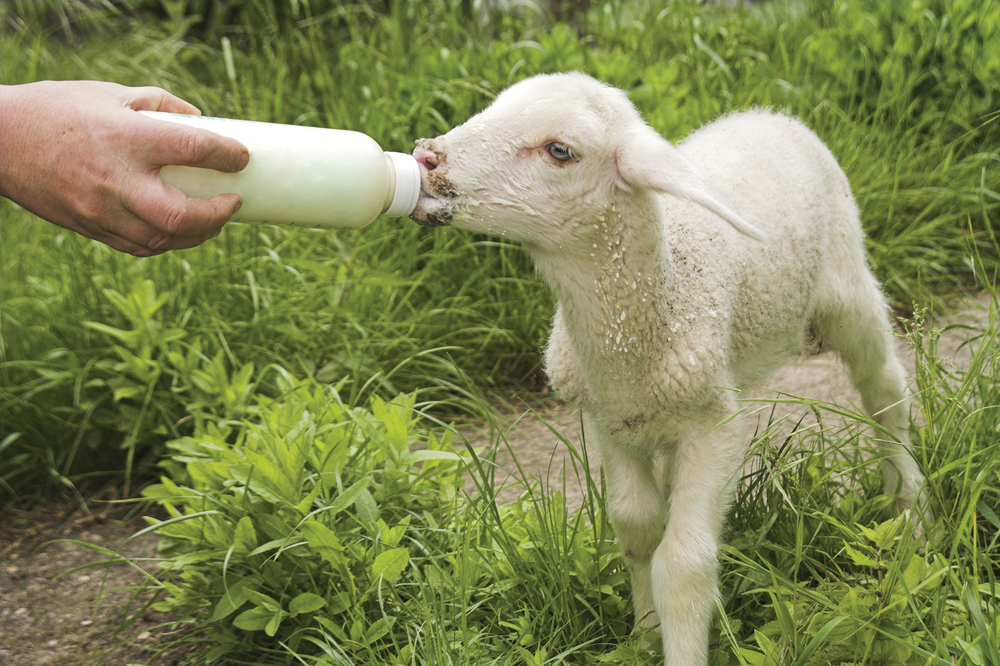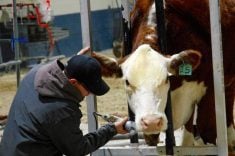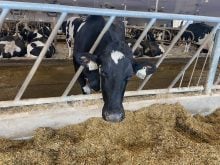For Martin Catto of Lipton, Sask., the choice of when to put lambs on his automatic milk feeder is an easy one.
If he gets triplets, one of the set goes on the feeder. If human-fed lambs start eating up more time than daily mechanical maintenance and cleaning, it’s time for an automated option.
“What’ll happen is that, if you leave the three lambs on that ewe, you’re going to get three small lambs instead of two good ones or two good ones and one dead one,” Catto said.
Read Also

VIDEO: Watering system a cattle health win
Portable livestock watering system helps Manitoba beef producer combat foot rot cases on pasture.
“When we start having enough lambs on the bottle that it takes more than 15 minutes, that’s when we fire up the machine.”
Why it matters: Mechanical feeders can have major labour savings and better health outcomes compared to bottle feeding, but producers say there must be enough lambs to make them worthwhile.
Catto estimates 15 to 20 lambs a week end up on his feeder in the heat of the season, and that number is easy to reach on his operation, which lambs about 200 ewes a week. At a lambing rate of about 180 per cent, there are about 360 lambs born weekly on Catto’s farm.
[RELATED] OMAFRA: Feeding systems for sheep
Of the triplets, the producer selects “the one that’ll be easiest to adopt to suck on the machine.”
“It might not be the one you pick first because he might not suck, so you just put him back and then you go for the next one.”
Once on the machine, Catto’s 32-day weaning cycle costs him $40 per lamb on average, he said. The number assumes that the lamb will use about half a bag of milk replacer in that time.
The Saskatchewan farmer was one of three sheep producer panelists at Brandon’s Ag Ex in late October. Each had a different perspective regarding milk feeders.
Pam Bartley doesn’t bother with either the bottle or the machine at her Saskatchewan operation due to the time constraints of her off-farm job. Any bottle lambs are sold.
Chris Eddy of Plumas, Man., opts for a pail system. That middle-of-the-road solution takes less time than bottle feeding but dodges the capital cost of an automatic feeder.
“It seems to work fairly well,” he said.
[RELATED] Farmtario: Sheep trucking requirements a concern for OSF members
Eddy is not against mechanical feeders. There were three of them at his previous job managing a large sheep operation.
The machine is worth it “when you’ve got too many to look after on your own,” Eddy said.
His current operation lambs about 60 ewes a month so “that doesn’t make sense for us to have a milk machine,” said Eddy’s son, Russell Eddy, during the panel discussion.
“With the milk machine, you still have to wash out your lines every day and clean it and perform regular maintenance, so for 20-30 lambs, it’s just as fast with the pail. If you went to having 100 to 300 lambs … then you need at least three milk machines, probably, to keep up with that. Pails would take all day.”

Materials originally distributed by the Canadian Sheep Federation and disseminated by the Alberta Lamb Producers in 2013 estimated the time commitment of an automatic milk feeder at about one hour a day, compared to six hours or more for bottle feeding.
And while bloat issues with milk replacer are a factor, the same document noted that lambs might be less prone to binging on an automated feeder, since the system allows for smaller, more numerous feedings throughout the day.
That means slower stomach absorption, leading to larger daily gains.
Milk machine maintenance is a sticking point, creating an added challenge with machine care, cleaning and draining.
[RELATED] Maedi visna: The hidden sheep disease
Talking numbers
Catto estimates the cost of his machine was $900 at the time of sale.
Eddy says the last feeder he saw, although larger, had a price tag of $3,000, while a higher-end feeder might cost $6,500 to $7,000.
Even at that price, Catto noted, “you pay $3,000 for that machine and on an operation like ours, we’re going to wean almost 400 lambs on it. If that machine’ll last you 10 years… it’s a very minimal cost.”
As for top end machines, Catto only sees the benefit in terms of ease of cleaning.
The extra profit brought by a third lamb will mean nothing, however, if that lamb succumbs to bloat. It’s an issue regardless of feeding style, though one that both Catto and Eddy have strategies to avoid.
Temperature is a big part of that equation, according to Catto.
“Young lambs, they go on it quicker if the milk is warm, but the older lambs, to prevent bloat, make sure the milk is cold, and then they don’t take too much,” he said.
[RELATED] Women show the way on shearing
Timing is the other key, according to both producers. Those who leave lambs on milk replacer when they’re much older than a month are courting issues with bloat.
“A lot of people…they keep them on at eight, 10 weeks old,” Eddy said. “(Producers) that wean them at 30, 32 days, they think we’re cruel, but it’s not if that lamb is doing well and he’s up to weight and he’s eating solid food.”
Standards
National Farm Animal Care Council standards require that milk replacer for lambs four weeks old and younger must be formulated specifically for lambs. However, that standard may soon change.
Research shows that bovine colostrum and milk replacer might be better than some current options, according to a recent five-year review. It suggests that the requirement be deleted in the updated standard.
The council also wants to take a deeper dive into automated milk feeder practices. The review identified a need for more research into the outcomes of bottle-fed versus feeder-fed lambs, including growth, health and impacts on disease spread.
There is also a question about which lambs should be removed from the mother. Researchers may discuss whether removing the strongest lamb or weakest lamb in a multiple birth leads to the best outcome and do a survivability study on larger versus smaller lambs raised on the feeder.
For his part, Catto does not notice any deficiency in lambs raised on the machine.
“We really don’t need to identify them now, because we know they do well,” he said. “Initially, when we first started with the machine, we always identified them so that we could go back and look at them later… but they do fine.”
















